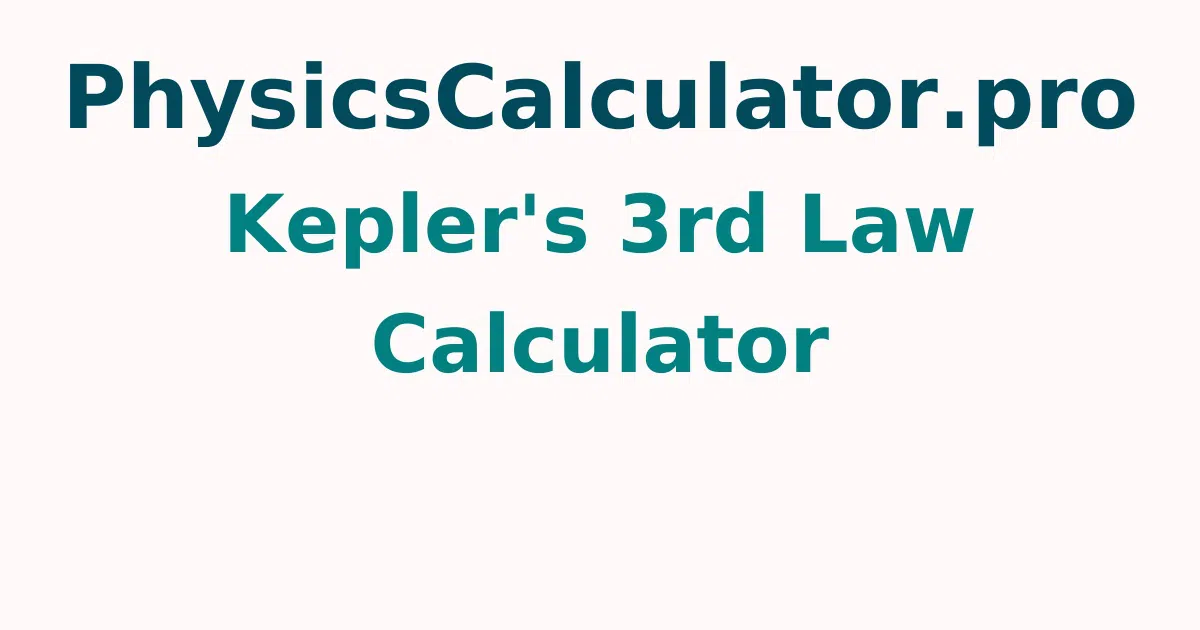Kepler's 3rd Law Calculator
Kepler's 3rd Law Calculator shows how to easily calculate the basic parameters of a planet's motion around the Sun, such as the semi-major axis and planet period. To find the unknown parameters, it uses Kepler's third law formula. To check the orbital period, simply enter the star's mass and semi-major axis and press the submit button.
What does Kepler's 3rd Law State?
According to Kepler's Third Law, the ratio of the squares of two planets' orbital periods is equal to the ratio of the cubes of their mean orbit radius. As per Kepler's Third Law, Every planet's orbit is an ellipse, with the Sun at one of the two foci. The cube of the semi-major axis of a planet's orbit is directly proportional to the square of its orbital period. The symbol 'T' stands for the Satellite Orbit Period.
Kepler's third law is used to calculate the velocity of a circular Earth orbit at any other distance r. The square of the orbital period is precisely proportional to the cube of the orbit's semi-major axis. The powerful online Kepler's Third Law Calculator is used to compute and find the planetary velocity when the Satellite Mean Orbital Radius(r) and Planet Mass(M) are known.
Kepler's Third Law Equation
The cube of a planet's radius is directly related to the square of its orbital period, according to Kepler's third law. T² ∝ a³
It depicts the relationship between a planet's orbital period and its distance from the sun in the system. The constant is the only variable in Kepler's third law.
a³/T² = 4 * π²/[G * (M + m)] = constant
- Where, a = semi-major axis
- T = planet period
- G = gravitational constant and it is 6.67408 x 10⁻¹¹ m³/(kgs)
- M = mass of the central star
- m = mass of the planet
How to Calculate Planet Period?
Use Kepler's 3rd law formula to compute the planet period in simple stages. They are explained as such
- Step 1: Find out about the star's mass and semi-major axis.
- Step 2: Calculate the radius's cube.
- Step 3: Multiply the mass of the star and the mass of the planet by the gravitational constant.
- Step 4: Multiply the result of the previous two stages.
- Step 5: Divide it by the 4π².
- Step 6: The planet period is the square root of the result.
Kepler's Third Law calculator
Kepler's third law calculator is simple to use and may be used in a variety of ways. Simply fill in two distinct fields, and we'll find out the third one then.
If you want to use a more precise version of Kepler's third rule of planetary motion, select advanced mode and provide the planet's mass, m. You may need to adjust the units to a smaller measure because the difference is too little to notice (e.g., seconds, kilograms, or feet).
Kepler's 3rd Law Examples
Question 1: Phobos orbits Mars at a distance of approximately 8200 kilometres from the planet's centre, with a rotational period of around 7 hours. Calculate the size of Mars.
Solution:
Given:
semi-major axis a = 8200 km = 8.2 x 10^6 m
Planet periord T = 7 hrs = 25200 sec
Kepler's equation is; a³/T² = 4 * π²/[G * (M + m)]
(8.2 x 10^6)³/(25200)² = 4 * π²/[6.67408 x 10⁻¹¹ * (M + m)]
8.68 x 10^11 = 39.43/[6.67408 x 10⁻¹¹ * (M + m)]
M + m = 39.43/57.93
M + m = 0.68
The mass of mars is 0.68 km.
For more concepts check out physicscalculatorpro.com to get quick answers by using this free tool.
FAQs on Kepler's Third Law Calculator
1. How do you calculate Kepler's Third Law?
When the orbit's size (a) is given in astronomical units (1 AU represents the average distance between the Earth and the Sun) and the period (P) is stated in years, Kepler's Third Law states that P2 = a3. where P is in Earth years, and a is astronomical units, and M is the mass of the centre object in Sun mass units.
2. What is the Third Law of Kepler?
According to Kepler's Third Law, the cubes of the semi-major axes of the planets' orbits are directly proportional to the squares of their orbital periods.
3. What is Kepler's K?
The square of the planet's orbital period divided by the cube of its semi-major axis is Kepler's constant. Note: When calculating the constant, Kepler assumed the orbit was circular and the radius was the orbit's average radius.
4. How do you calculate Kepler's Constant?
For that one object being orbited, the square of the period of orbit divided by the cube of the radius of the orbit equals a constant (Kepler's Constant).
